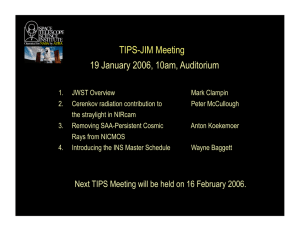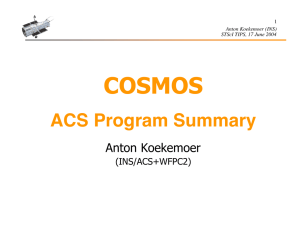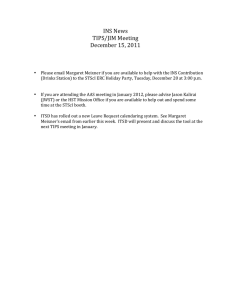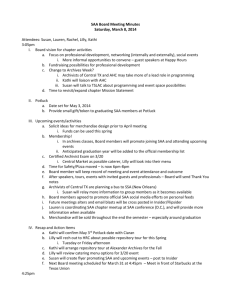Removing SAA-Persistent Cosmic Ray Flux from NICMOS
advertisement
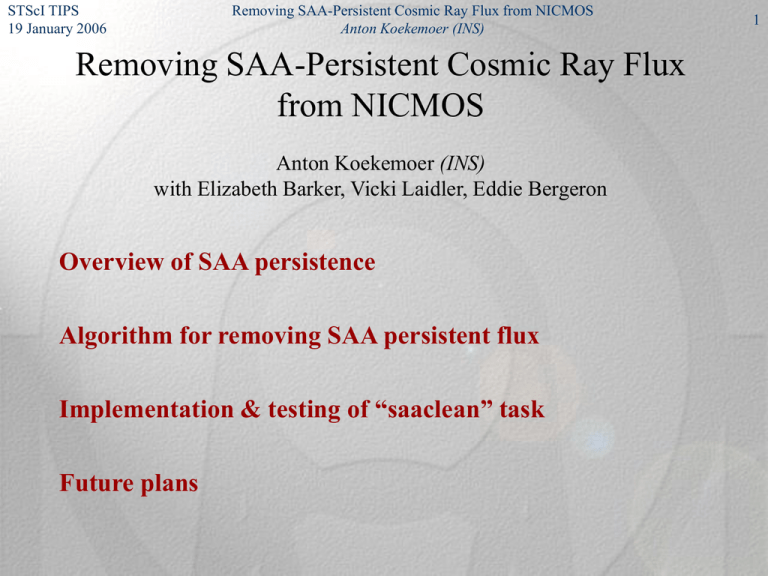
STScI TIPS 19 January 2006 Removing SAA-Persistent Cosmic Ray Flux from NICMOS Anton Koekemoer (INS) Removing SAA-Persistent Cosmic Ray Flux from NICMOS Anton Koekemoer (INS) with Elizabeth Barker, Vicki Laidler, Eddie Bergeron Overview of SAA persistence Algorithm for removing SAA persistent flux Implementation & testing of “saaclean” task Future plans 1 STScI TIPS 19 January 2006 Removing SAA-Persistent Cosmic Ray Flux from NICMOS Anton Koekemoer (INS) SAA Persistence Overview of Persistence: NICMOS HgCdTe/CdTe bulk material contains small flaws that trap electrons produced by detected photons The trapped electrons are not read out together with all the other electrons detected in a given pixel Thermal excitation causes (Bergeron & Dickinson, NICMOS-ISR-2003-10) traps to release the electrons on longer timescales with a logarithmic decay Resulting flux appears in subsequent exposures, with a distribution that depends on the original intensity and the population of traps 2 STScI TIPS 19 January 2006 Removing SAA-Persistent Cosmic Ray Flux from NICMOS Anton Koekemoer (INS) South Atlantic Anomaly (SAA): Region in Earth’s magnetosphere where Van Allen belts dip closest to the surface, resulting from misalignment in Earth’s magnetic axis HST passes through it ~50% of the time, 8-9 orbits/day Although NICMOS is powered off, cosmic ray electrons are still trapped Cosmic ray rate is so high that persistence can increase total noise by 4-5x in subsequent exposures obtained long after the SAA passage (O. Lupie, WFC3-ISR-2002-01) (Bergeron & Dickinson, NICMOS-ISR-2003-10) 3 STScI TIPS 19 January 2006 Removing SAA-Persistent Cosmic Ray Flux from NICMOS Anton Koekemoer (INS) Removing SAA Persistent Flux Post-SAA darks: After each SAA passage when NICMOS transitions from SAAOPER to OPERATE, a pair of dark exposures is obtained: – ACCUM mode, NREAD=25, EXPTIME=256s – Darks start 174s and 444s after exiting the SAA Calibrate the darks to remove other instrumental signatures (pedestal etc) Create average post-SAA dark image: – scale the 2nd dark to the level of the 1st dark, using the decay time constant – average the 2 darks to remove CRs accumulated during the dark exposures (Bergeron & Dickinson, NICMOS-ISR-2003-10) 4 STScI TIPS 19 January 2006 Removing SAA-Persistent Cosmic Ray Flux from NICMOS Anton Koekemoer (INS) Subtracting the SAA model: The average of the 2 post-SAA darks is the SAA model, representing all the CRs accumulated during SAA passage Scale and subtract from the calibrated (pedestal-corrected) science image Scale factor is determined iteratively: – – – – multiply SAA model image by small scale factors subtract from science image measure the resulting noise (FWHM of Gaussian fit to pixel histogram) Plot noise as a function of scale factor, fit parabola to determine optimal scale 5 STScI TIPS 19 January 2006 Removing SAA-Persistent Cosmic Ray Flux from NICMOS Anton Koekemoer (INS) Fitting for High and Low pixels: Some CRs during SAA have higher energy and/or occur later than others Need to fit different scale factors, depending on the level of the residual signal In practice, divide the pixel histogram into 2 regimes: low and high Determine separate scale factors, and only apply a correction if the reduction in noise is > 1% 6 STScI TIPS 19 January 2006 Removing SAA-Persistent Cosmic Ray Flux from NICMOS (Barker & Koekemoer, 2005 HST CalKoekemoer Workshop (INS) Anton Example Results Before SAAclean Post-SAA Dark After SAAclean SAA CR Persistence model 7 STScI TIPS 19 January 2006 Removing SAA-Persistent Cosmic Ray Flux from NICMOS Anton Koekemoer (INS) Implementation of SAAclean task Original script: IDL, provided by E.Bergeron New version: Python code, written by Vicki Laidler, following original IDL prototype Installed as Pyraf/STSDAS hst_calib.nicmos.saaclean Some slight differences in algorithms (mostly related to IDL fitting functions that are unavailable or different in Pyraf) Inputs: – calibrated exposure (optionally corrected for pedestal effect) – Post-SAA darks (read from the image header) Output: – – – – calibrated exposure with the SAA model subtracted SAA model (in off-line version) Lots of output text containing information about the fitting process Fitting parameters also stored in header keywords 8 STScI TIPS 19 January 2006 Removing SAA-Persistent Cosmic Ray Flux from NICMOS Anton Koekemoer (INS) Testing Procedures Compare IDL and Pyraf versions: run on the full variety of datasets, ranging from extreme SAA events to datasets that are not impacted resulting model files and output images compared, examining: – noise in the images – individual pixels – dependence on quality of bad pixel files Results: – some differences between IDL and Pyraf; generally only in treatment of bad pixels, while SAA-impacted pixels showed the same behaviour Full test of the Pyraf version: Ran on all SAA-impacted NIC1,2,3 exposures ever obtained (>6,000) Examined images, as well as the output values of: – – – – chi-sq nhigh/nlow pixels and the threshold value scale correction factor noise reduction values 9 STScI TIPS 19 January 2006 Removing SAA-Persistent Cosmic Ray Flux from NICMOS Anton Koekemoer (INS) Future Plans Off-line version: Prototype version was released publicly in STSDAS 3.4 (Nov 1, 2005) Available for use within STScI and in the outside community; feedback solicited Finalize addressing minor issues turned up in very extreme datasets (very low or very high chi-sq, or low/high pixel regimes not well modelled): – appears that all of these can be fixed by using the correct bad pixel files Add some additional parameters to improve flexibility of iterations Next release likely in Feb/Mar 2006 Pipeline version: Aim to incorporate all improvements in off-line version by Feb/Mar 2006 Likely release to OPUS in Apr/May 2006 Initially only run on data that is within 1 orbit of SAA passage Correction only applied if noise reduction is >1% Continue to solicit feedback from community 10

